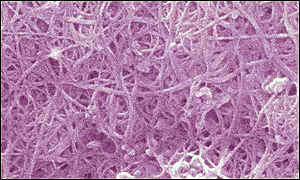| Artificial Muscles Made From Nanotubes |
|
||||
|
Stiquito Kit BattleKits Robot Toys Solar Kits Robot Arms Robosapien Basic Stamp Kits Lego MindStorms
Hobby Robots Robot Sports Electronics Mechanics Robot Minds Books for Kids Robots at Work Microcontrollers Advanced Books Used Books
Robot Motors Remote Controls Robot Parts Robot Tools Magazines Robot Videos Robot News RoboLinks Contact
|
Courtesy BBC News This "paper" is made of nanotubes and contracts when charged "Artificial muscles" have been made from millions of carbon nanotubes. Like natural muscles, providing an electrical charge causes the individual fibers to expand and the whole structure to move. However, any application of this work in replacing biological muscles is "nearer the dream factory than reality". The real benefit of the breakthrough may come in generating energy from ocean waves. Small but powerful Nanotubes are cylindrical molecules made of carbon atoms and are only a millionth of a millimeter in diameter. Their strength, flexibility and electrical properties have fascinated scientists. The new research, published in Science, shows for the first time that the tiny tubes expand and contract their length by about 1% when an electrical charge is applied and then removed. The team demonstrated this by creating a double sheet of nanotubes "paper". A mat of nanotubes was stuck to each side of a piece of double-sided sticky tape and placed in a fluid that conducts electricity. When a current was applied to one side of the "paper", it curled up showing that the tubes had expanded. Bending back Reversing the process would allow the nanotubes to be used as energy generators. Bending the tubes back and forth would create an electric current. Dr Siegmar Roth, a member of the team at the Max Planck Institute, Stuttgart, Germany, told BBC News Online: "This would be good for ocean waves because they give and release a mechanical load as the waves go up and down." Dr Roth says the nanotubes would be an exceptional material for this application, but adds: "It is not just the material, but the whole system which is crucial. Whether it could compete against other ways of generating energy is an open question. "But the situation could be different in year," Dr Roth says. "Now we know the nanotubes move when we apply a charge, we can start to look at how they behave as energy generators." Nanomachines Using single nanotubes as electrically driven robot-arms, called actuators, in tiny machines is an even longer-term goal. "I think it will take about 20 years for these to exist," says Dr Roth. "You not only have to have an actuator, but also other elements which control this. So a lot of development has to be put in." Other materials which can be used as actuators already exist, such as conducting polymers, but nanotube actuators could work harder, faster and longer than these. Fuel cells Not all nanotube applications are decades away. Significant research funds have been invested in finding out whether the tubes could store hydrogen for use in car fuel cells. The results of feasibility studies are expected within a year and a product could be built by 2004. Ultra-thin display screens are another application which is close to market if research shows it to be economic. Here, each tube delivers photons of light, resulting in an extremely thin and high-resolution display. Samsung in Korea are producing these field-emission devices on a laboratory scale at the moment. |
||||
|
Advertise your product on RobotBooks.com Beginners Books |
Hobby Robots |
Robot Sports |
Electronics |
Mechanics |
Robot Minds |
Robot Fiction |
|||||